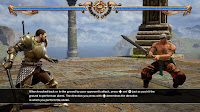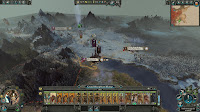The best way to describe my
initial impressions of Soul Calibur VI (and yes, I know it’s
‘SoulCalibur’ but I prefer it with the space) is to say that it’s
good
but it should be better.
It’s kind of frustrating because the foundation is here to build
what should have been the definitive Soul Calibur game. At least,
that’s how I feel right now, with just over 15 hours played. As I
sink more time into the game, my opinion may change, so keep that in
mind.
I haven’t really got
stuck into a fighting game for several years. In fact, the last time
I did was probably Soul Calibur IV a decade or so ago. The original
SC on the Dreamcast was one of my favourite games on the platform, as
was SC II on the GameCube. But I didn’t play SC III or V, and I’ve
kind of drifted away from the fighting genre ever since SC IV.
So I was kind of excited to
return to the series with VI. I think I probably preferred the SC
series because it’s a more ‘casual’ fighter in the sense that
it’s far easier to pick up and play. The button combos aren’t
needlessly convoluted or tricky to perform and many characters share
similar inputs, so even if you’ve never played a particular
character before, you’ll already have a foundation of basic moves
upon which to build. SC
was never really about mastering complicated combos. It was more
about movement, timing and precision. Knowing the right move to
perform and when
for the greatest impact.
I also liked the focus on
solo/story content. Whereas many recent fighters seem to be more
focused on online/tournament play, SC VI offers a substantial single
player experience. It’s best to begin with ‘Libra of Souls’ –
a story based mode in which you create a custom character – because
it offers a good range of tutorials that explain various aspects of
the combat system.
Libra is an RPG-lite in the
sense that you ‘level up’ as you traverse the world and complete
missions, but it’s pretty basic. You can buy or win new weapons,
some of which can be upgraded with unique boosts, but it’s a very
limited system. The story of Libra will carry you across the world
and your custom character will encounter the ‘main’ cast of SC VI
at various points.
It’s a story that runs
parallel to that of the ‘core’ SC VI story and I’ve enjoyed
what I’ve seen so far. It starts slow, with a lot of very easy,
single round fights. But once you start hitting level 25-30, that’s
when it gets a little more interesting. I’m currently level 33 and
I’ve just had a couple of very challenging ‘boss’ style fights
and it appears I’ve still got a long way to go.
I also like that you can
totally change your character or weapon at any time, so you’re not
locked to a particular look or style. In addition to the Libra is the
core story mode – Soul Chronicle – in which every character has
their own unique segment that combines into a complete tale. But I
haven’t got stuck into this mode yet, so I can’t really comment
on it here.
And then we have Arcade
mode, which is a little strange in the sense that’s it’s just
eight random fights – there’s no ‘boss’ fight at the end.
You’re also only
ranked on time taken. I’ve played it a couple of times and it’s
fine,
I guess, but it feels a little tacked on. You also have the standard
Versus mode against the CPU, and a training mode to learn the various
moves.
The training mode is
decent, but not great. Although I’ve gotten used to seeing the
button inputs displayed as they would on a fight stick and not on my
360 pad – where A is X and B is Y – it would have been nice if
you had the option to display the inputs according to your chosen
controller. It would also be nice to be able to display them on the
screen
as you practice, rather than having to enter and exit the various
menus every time you want to learn a new combo.
The custom character
creator is a lot of fun, and I’ve probably spent a couple of hours
just messing around with it. I do understand people not wanting
custom characters in ranked – because some people design characters
that use equipment to intentionally ‘hide’ their character
animations, making it very difficult to read or respond – but those
incidents are pretty rare from what I’ve seen, and I quite like
seeing all the crazy shit people have created.
Which leads us onto online
play which I’ve enjoyed a lot more than I thought I would. It has
its problems, no doubt. I’ve had several network errors kicking me
out of a match, and lag can sometimes kick in making everything seem
like it’s running in slow motion. In a way, I kind of prefer
getting matched against higher ranked players because I know that –
even if I lose – I’m going to get a pretty good fight.
I like to win, don’t get
me wrong, but I also like a good scrap that goes right to the wire. I
like fights where I can mix up my play. Where it’s a little more
tactical. Cat and mouse. Where, even if I lose, I feel like I had a
good time and maybe learnt something new. Of course, not every online
fight is like this. There’s a lot of players who just spam one or
two heavy combos and try to pin you against a wall or get an easy
ring out.
It’s not my place to tell
people how to play or enjoy the game, but I can’t say I find these
fights much fun because the best way to defeat them is to simply find
a combo they don’t know how to counter and spam it right back at
them. Sure, I like winning, but winning like that just isn’t much
fun, at least for me. I prefer matches where I get to see a range of
moves and tactics, even if I lose. The ‘spam’ attack matches are
kind of anti-fun, but it’s just something you have to learn to deal
with.
Visually, SC VI looks
dated.
It doesn’t look bad, but it doesn’t look as good as it should,
either. The character models don’t look much better than I remember
in IV, and the stages look even worse. The production value, at least
as far as the visuals go, is poor considering the price. Which leads
us back to my initial impressions that everything Soul Calibur VI
does it does well
– but it could and should
have done it better. That said, I’m certainly enjoying my time with
the game and once I’ve completed Libra and the core story mode,
I’ll be sure to post a final review.



























